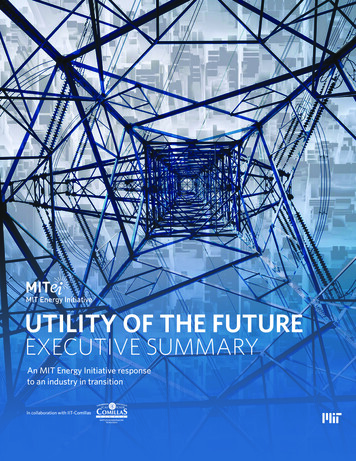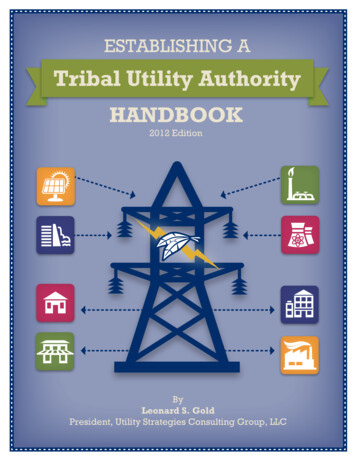
Transcription
UTILITY OF THE FUTUREEXECUTIVE SUMMARYAn MIT Energy Initiative responseto an industry in transitionIn collaboration with IIT-Comillas
Full report can be found at: energy.mit.edu/uofCopyright 2016 Massachusetts Institute of TechnologyAll rights reserved.Incorporated in the cover art is animage of a voltage tower. iStockand an aerial view of buildings ShutterstockISBN (978-0-692-80824-5)
UTILITY OF THE FUTURE:EXECUTIVE SUMMARYAn MIT Energy Initiative response to an industry in transition
Study ParticipantsPrincipal InvestigatorsIGNACIO PÉREZ-ARRIAGACHRISTOPHER KNITTELProfessor, Electrical Engineering, Institute for Researchin Technology, Comillas Pontifical UniversityGeorge P. Shultz Professor of Applied Economics,Sloan School of Management, MITVisiting Professor, MIT Energy InitiativeDirector, Center for Energy and EnvironmentalPolicy Research, MITProject DirectorsRAANAN MILLERRICHARD TABORSExecutive Director, Utility of the Future Study,MIT Energy InitiativeVisiting Scholar, MIT Energy InitiativeResearch TeamASHWINI BHARATKUMARMAX LUKEPhD Student, Institute for Data, Systems,and Society, MITSM, Technology and Policy Program (’16), MITMICHAEL BIRKSM, Technology and Policy Program (’16), MITExecutive Director, Utility of the Future Study,MIT Energy InitiativeSCOTT BURGERPABLO RODILLAPhD Student, Institute for Data, Systems,and Society, MITResearch Scientist, Institute for Research in Technology,Comillas Pontifical UniversityJOSÉ PABLO CHAVESRICHARD TABORSResearch Scientist, Institute for Research in Technology,Comillas Pontifical UniversityVisiting Scholar, MIT Energy InitiativePABLO DUENAS-MARTINEZResearch Scientist, MIT Energy InitiativePostdoctoral Associate, MIT Energy InitiativeRAANAN MILLERKAREN TAPIA-AHUMADACLAUDIO VERGARAIGNACIO HERREROPostdoctoral Associate, MIT Energy InitiativeResearch Assistant, Institute for Research in Technology,Comillas Pontifical UniversityNORA XUSM, Technology and Policy Program (’16), MITSAM HUNTINGTONSM, Technology and Policy Program (’16), MITJESSE JENKINSPhD Candidate, Institute for Data,Systems and Society, MIT
Faculty CommitteeROBERT ARMSTRONGWILLIAM HOGANDirector, MIT Energy InitiativeRaymond Plank Professor of Global Energy Policy, John F.Kennedy School of Government, Harvard UniversityCARLOS BATLLEResearch Scholar, MIT Energy InitiativeSTEVEN LEEBProfessor, Institute for Research in Technology,Comillas Pontifical UniversityProfessor, Electrical Engineering & Computer Science andMechanical Engineering, MITMICHAEL CARAMANISRICHARD LESTERProfessor of Mechanical Engineering and SystemsEngineering, College of Engineering, Boston UniversityAssociate Provost and Japan Steel Industry Professorof Nuclear Science and Engineering, Office of theProvost, MITJOHN DEUTCHInstitute Professor, Department of Chemistry, MITLESLIE NORFORDProfessor, Department of Architecture, MITTOMÁS GÓMEZProfessor, Institute for Research in Technology,Comillas Pontifical UniversityJOHN PARSONSSenior Lecturer, Sloan School of Management, MITRICHARD SCHMALENSEEHoward W. Johnson Professor of Economics andManagement, EmeritusDean, Emeritus, Sloan School of Management, MITResearch and Project AdvisorsLOUIS CARRANZAÁLVARO SÁNCHEZ MIRALLESAssociate Director, MIT Energy InitiativeSenior Associate Professor, Institute for Research inTechnology, Comillas Pontifical UniversitySTEPHEN CONNORSDirector, Analysis Group for Regional Energy Alternatives,MIT Energy InitiativeFRANCIS O’SULLIVANCYRIL DRAFFINROBERT STONERProject Advisor, MIT Energy InitiativeDeputy Director for Science and Technology,MIT Energy InitiativePAUL MCMANUSMaster Lecturer, Questrom School of Business,Boston UniversityResearch Director, MIT Energy Initiative
Advisory CommitteePHILIP SHARPCHRISTIANA LA MARCAUtility of the Future Advisory Committee Chair andRetired President, Resources for the FutureHead of Innovation, Global Thermal Generation, EnelRICHARD O’NEILLPresident & Founder, Opower*Utility of the Future Advisory Committee Vice ChairChief Economic Advisor, Federal EnergyRegulatory CommissionM. MASOOD AHMADDivision Head, Power Systems Planning Department,Saudi AramcoALEX LASKEYANDREW LEVITTSr. Market Strategist, PJM Interconnection*BLANCA LOSADA MARTINChief Executive Officer, Gas Natural Fenosa Engineering.Chief Technology Officer, Gas Natural FenosaJANET GAIL BESSERLUCA LO SCHIAVOExecutive Vice President, Northeast CleanEnergy CouncilDeputy Director, Infrastructure Regulation, AEEGSI —Italian Regulatory Authority for Electricity, Gas,and WaterALAIN BURTINDirector, Energy Management, EDF R&D*GARY RAHLExecutive Vice President, Booz Allen HamiltonPAUL CENTOLELLAPresident, Paul Centolella & Associates LLCMARK RUTHSenior Consultant, Tabors Caramanis RudkevichPrincipal Project Lead, Strategic Energy Analysis Center,National Renewable Energy LaboratoryMARTIN CROUCHHead of Profession for Economists and Senior Partner,Improving Regulation, OfgemELIZABETH ENDLERResearch Program Manager, Shell InternationalExploration & Production (US) Inc.PHIL GIUDICEChief Executive Officer, President and Board Member,Ambri Inc.TIMOTHY HEALYChief Executive Officer, Chairman andCo-Founder, EnerNOCMARIANA HEINRICHMIGUEL SÁNCHEZ-FORNIEDirector, Global Smart Grids, IberdrolaMANUEL SÁNCHEZ-JIMÉNEZ, PHDTeam Leader Smart Grids, European CommissionLAURENT YANADirector Advisor of Global BUs,Group Strategy Division, EngieAUDREY ZIBELMANChair, New York State Public Service Commission* The MIT Energy Initiative also wishes to thank thefollowing former Advisory Committee members:Manager, Climate & Energy, World Business Councilfor Sustainable DevelopmentREGINE BELHOMME (EDF)PAUL JOSKOWJIM KAPSIS (Opower)President, Alfred P. Sloan FoundationElizabeth and James Killian Professor of Economics,Emeritus, MITMELANIE KENDERDINEDirector of the Office of Energy Policy and SystemsAnalysis and Energy Counselor to the Secretary,U.S. Department of EnergySUSAN COVINO (PJM)
ContentsVIForeword and AcknowledgmentsVIIIExecutive Summary1Part 1: Understanding Electricity Services and How Distributed EnergyResources Affect the Design and Operation of Power Systems1Chapter 1: A Power Sector in Transition19Chapter 2: New Options for the Provision and Consumption of Electricity Services35Chapter 3: Envisioning a Future with Distributed Energy Resources75Part 2: A Framework for an Efficient and Evolving Power System75Chapter 4: A Comprehensive and Efficient System of Prices and Regulated Charges forElectricity Services137Chapter 5: The Future of the Regulated Network Utility Business Model185Chapter 6: Restructuring Revisited: Electricity Industry Structure in a More Distributed Future227Chapter 7: The Re-Evolution of Short- and Long-Term Electricity Market Design265Part 3: Insights on the Economics of Distributed Energy Resources and theCompetition between Centralized and Distributed Resources265Chapter 8: Understanding the Value of Distributed Energy Resources307Part 4: A Policy and Regulatory Toolkit for the Future Power System307Chapter 9: A Toolkit for Regulators and Policy Makers325Appendix A325A Description of the Computational Models Used in This Study339Appendix B339A Review of Business Models for Distributed Energy ResourcesFull report and related working papers are available at: energy.mit.edu/uof
Forewordand AcknowledgmentsAn important evolution in the provision and consumption of electricity services is now underway, driven to a significant degree by a confluence of factors affecting the distribution side of thepower system. A range of more distributed technologies — including flexible demand, distributedgeneration, energy storage, and advanced power electronics and control devices — is creatingnew options for the provision and consumption of electricity services. In many cases, these novelresources are enabled by increasingly affordable and ubiquitous information and communicationtechnologies and by the growing digitalization of power systems. In light of these developments,the MIT Energy Initiative’s Utility of the Future study examines how the provision and consumptionof electricity services is likely to evolve over the next 10 to 15 years in different parts of the worldand under diverse regulatory regimes, with a focus on the United States and Europe.The Utility of the Future study is the first of a new seriesThis study does not attempt to predict the future. Weof reports that is being produced by the MIT Energyfollow the dictum of poet and author Antoine de SaintInitiative (MITEI) to serve as balanced, fact-based, andÉxupéry: “As for the future, your task is not to foresee,analysis-driven guides to key topic areas in energy forbut to enable it.” We identify key barriers and skeweda wide range of decision makers in government andincentives that presently impede the efficient evolutionindustry. This study specifically aims to serve as a guideof the power sector and offer a framework for regulatoryfor policy makers, regulators, utilities, existing and startupand market reform, based on a comprehensive systemenergy companies, and other power-sector stakeholdersof efficient economic signals, that will enable an efficientto better understand the factors that are currently drivingoutcome, regardless of how technologies or policychange in power systems worldwide. The report distillsobjectives develop in the future.results and findings from more than two years of primaryresearch, a review of the state of the art, and quantitativemodeling and analysis.VI MIT Energy Initiative: Utility of the Future
MITEI’s Utility of the Future study was supportedThis study was initiated and performed within MITEI.by a consortium of 23 diverse organizations fromProfessor Robert Armstrong has supported this study inacross the energy sector, and it is complemented byhis role as director of MITEI and as an active participant[a] distinguished Advisory Committee and Facultyin the faculty committee. Louis Carranza, associateCommittee. We gratefully acknowledge the supportdirector of MITEI, structured the commercial model andof the following consortium members at the Sponsorworked closely with study executive director Raananlevel: Booz Allen Hamilton, EDF, Enel, Engie, Gas NaturalMiller in assembling the consortium members. MITEIFenosa, General Electric Corporation, Iberdrola, Nationalstaff provided administrative and financial managementRenewable Energy Laboratory, PJM, Saudi Aramco, Shell,assistance to this project; we would particularly like toUS Department of Energy, and World Business Councilthank Emily Dahl, Debra Kedian, Francesca McCaffrey,for Sustainable Development. At the Participant levelChelsey Meyer, Jennifer Schlick, Jessica Smith, and Kelleywe wish to thank: The Charles Stark Draper Laboratory,Travers for communications and event support. Finally, weDuke Energy, Enzen, Eversource, Lockheed Martin,would like to thank Kathryn O’Neill and Marika TatsutaniNEC Corporation, PSE&G, Siemens, and Statoil. At thefor editing this document with great skill and patience,Observer level we wish to thank Paul and Matthewand Opus Design for layout and figure design.Mashikian. In addition to providing financial support,a number of our sponsors provided data that werehelpful for our modeling activities. We are very gratefulfor this assistance.This report represents the opinions and views of theresearchers who are solely responsible for its content,including any errors. The Advisory Committee andthe Study Consortium Members are not responsibleOur Advisory Committee members dedicated afor, and do not necessarily endorse, the findings andsignificant amount of their time to participate in meetingsrecommendations it contains.and to comment on our preliminary analysis, findings,and recommendations. We would especially liketo acknowledge the efficient conduct of AdvisoryCommittee meetings under the able and experiencedThis report is dedicated to the memory of our friend andcolleague Stephen Connors.direction of Chairman Philip R. Sharp and Vice ChairmanRichard O’Neill.FOREWORD AND ACKNOWLEDGMENTS VII
ExecutiveSummaryImportant changes in the provision and consumption of electricity services are now underway,driven to a significant degree by a confluence of factors affecting the distribution side of powersystems. A variety of emerging distributed technologies — including flexible demand, distributedgeneration, energy storage, and advanced power electronics and control devices — are creatingnew options for the provision and consumption of electricity services. At the same time,information and communications technologies are rapidly decreasing in cost and becomingubiquitous, enabling more flexible and efficient consumption of electricity, improved visibility ofnetwork use, and enhanced control of power systems.These technologies are being deployed amidst severalfor distribution utilities that reward cost savings,broad drivers of change in power systems, includingperformance improvements, and long-term innovation;growth in the use of variable renewable energy sourcesreevaluation of the power sector’s structure to minimizesuch as wind and solar energy; efforts to decarbonizeconflicts of interest; and recommendations for thethe energy system as part of global climate changeimprovement of wholesale electricity markets. This studymitigation efforts; and the increasing interconnectednessalso offers a set of insights about the roles of distributedof electricity grids and other critical infrastructure,energy resources, the value of the services thesesuch as communications, transportation, and naturalresources deliver, and the factors most likely to determinegas networks.the portfolio of cost-effective resources, both centralizedThe MIT Energy Initiative’s Utility of the Future studypresents a framework for proactive regulatory, policy, andmarket reforms designed to enable the efficient evolutionand distributed, in different power systems. We considera diverse set of contexts and regulatory regimes, butfocus mainly on North America and Europe.of power systems over the next decade and beyond.This study does not try to forecast the future or predictThe goal is to facilitate the integration of all resources,which technologies will prevail. Instead, it identifiesbe they distributed or centralized, that contribute to theunnecessary barriers and distortionary incentives thatefficient provision of electricity services and other publicpresently impede the efficient evolution of the powerobjectives. This framework includes a comprehensivesector and provides a framework that will enable anand efficient system of market-determined prices andefficient outcome regardless of how technologies orregulated charges for electricity services that reflect,policy objectives develop in the future. In addition,as accurately as possible, the marginal or incrementalwe recognize that regulatory and policy reform oftencost of providing these services; improved incentivesproceeds incrementally and that each jurisdiction facesVIII MIT Energy Initiative: Utility of the Future
unique challenges and contexts. As such, we offer thisseveral flaws in current ratemaking. The rapid uptakeframework along with guidance on the key trade-offsof solar PV also demonstrates how quickly customersregulators and policy makers confront as they pursuecan react to economic signals — whether well or poorlyopportunities for progressive improvements.designed — and the importance of proactive, ratherThe measures identified in this study could producesignificant cost savings. Low-cost information andcommunications technologies and advanced meteringenable more cost-reflective prices and charges forthan reactive, policy-making and regulation. In multiplejurisdictions, challenges that once seemed insignificanthave quickly become overwhelming, and failure to act cancatch policy makers and regulators flat-footed.electricity services that can finally animate the “demandThe framework proposed in this study is designedside” of the power system and align myriad decisions withto establish a level playing field for the provisionthe optimization of net social welfare. Efficient prices andand consumption of electricity services, whether viacharges will unlock flexibility in electricity consumptioncentralized or distributed resources. The goal is toand appropriately value the services that distributedremove inefficient barriers to the integration of cost-energy resources provide. To date, power systems haveeffective new sources of electricity services, rethinkbeen designed to meet infrequent peaks in demand andill-designed incentives for certain resources, and presentto comply with engineering safety margins established ina system of prices and charges that can animate efficientan era when electricity customers were largely inflexibledecisions. With this framework in place, all customersand blind to the true costs and potential benefits ofand producers of electricity services can make efficienttheir electricity consumption or production decisions. Inchoices based on accurate incentives that reflect themany cases, this has resulted in costly and significantlyeconomic value of these services and their own diverseunderutilized infrastructure. Smarter consumption ofpersonal preferences.electricity and, where cost-effective, the deploymentof distributed energy resources, could deliver billionsof dollars in savings by improving the utilization ofelectricity infrastructure.At the same time, the need for proactive reform is clear.Customers now face unprecedented choice regardinghow they get their power and how they manage theirelectricity consumption — regardless of whether theyare aware of those choices or are acting on themtoday. New opportunities include the ability to investin distributed generation, smart appliances, and energyefficiency improvements. At present, the vast majorityof power systems lack a comprehensive system ofefficient prices and regulated charges for electricityservices. As a result, some customers are makinginefficient investments and are overcompensated forThis study highlights several core findings:The only way to put all resources on a level playingfield and achieve efficient operation and planningin the power system is to dramatically improveprices and regulated charges (i.e., tariffs or rates)for electricity services. To establish a level playing field for all resources,cost-reflective electricity prices and regulated chargesshould be based only on what is metered at the pointof connection to the power system — that is, the profileof injections and withdrawals of electric power at agiven time and place, rather than the specific devicesbehind the meter. In addition, cost-reflective pricesand regulated charges should be symmetrical, withinjection at a given time and place compensated at thesame rate that is charged for withdrawal at the sametime and place.the services that they provide to the power system. Atthe same time, many more opportunities that coulddeliver greater value are being left untapped because ofinadequate compensation. For example, the combinationof simple volumetric tariffs and net metering policieshas contributed to the rapid adoption of rooftop solarphotovoltaics (PV) in several jurisdictions, while exposing Increasingly affordable information and communicationstechnologies (e.g., advanced meters or interval meters)enable detailed monitoring of electricity withdrawals andinjections and therefore facilitate more efficient pricesand charges. Without more accurate consumption andinjection data from all customers, it is impossible tocapture the full value of electricity services.EXECUTIVE SUMMARY IX
Flat, volumetric tariffs are no longer adequate fortoday’s power systems and are already responsiblefor inefficient investment, consumption, andoperational decisions. Peak-coincident capacity charges that reflect users’contributions to incremental network costs incurred tomeet peak demand and injection, as well as scarcitycoincident generating capacity charges, can unlockflexible demand and distributed resources and enablesignificant cost savings. Granularity matters. The value or cost of electricityservices can vary significantly at different times and atdifferent locations in electricity networks. Progressivelyimproving the temporal and locational granularityof prices and charges for these services can deliverincreased social welfare. However, these benefits mustbe balanced against the costs, complexity, and potentialequity concerns of implementation. Care must be taken to minimize distortions fromcharges that are designed to collect taxes, recover thecosts of public policies (such as efficiency programs,heating assistance, subsidies for renewable energy,cross-subsidies between different categories ofcustomers, etc.), and recover residual network costs(i.e., those network costs that are not recovered viacost-reflective charges). Policy makers and regulators must be wary of thepossibility of societally inefficient “grid defection” ifresidual network costs and policy charges become toohigh. This may suggest an upper limit on the portionof these costs that can be collected in electricity tariffsrather than through broader taxes or other means.The regulation of distribution utilities must beimproved to enable the development of moreefficient distribution utility business models. Forward-looking, multi-year revenue trajectories withprofit-sharing mechanisms can reward distributionutilities for cost-saving investments and operations,aligning utilities’ business incentives with the continualpursuit of novel solutions. Several “state of the art” regulatory tools, includingan incentive-compatible menu of contracts, anengineering-based reference network model, andautomatic adjustment factors to account for forecasterrors, can better equip regulators for an evolving anduncertain electricity landscape.X MIT Energy Initiative: Utility of the Future Equalizing financial incentives related to capitaland operational expenditures can free utilities topursue cost-effective combinations of conventionalinvestments and novel operational expenditures(including payments to distributed resources). Outcome-based performance incentives can rewardutilities for improvements in quality of service, such asenhanced resiliency, reduced distribution losses, andimproved interconnection times. Incentives for longer-term innovation are neededto accelerate investment in applied R&D anddemonstration projects and learning about thecapabilities of novel technologies and practices thatmay have higher risk or longer-term payback periods.The structure of the electricity industry shouldbe carefully reevaluated to minimize potentialconflicts of interest. Network providers, system operators, and marketplatforms constitute the critical functions that sit at thecenter of all transactions in electricity markets. Properlyassigning responsibilities for these core functions isthus critical to an efficient, well-functioning electricitysector. It is also critical to establish a level playing fieldfor the competitive provision of electricity servicesby traditional generators, network providers, anddistributed energy resources. As experience with restructuring in the bulk powersystem has demonstrated, structural reform thatestablishes financial independence betweendistribution system operation and planning functionsand competitive market activities would be preferablefrom the perspective of economic efficiency and wouldfacilitate more light-handed regulation. If financial independence is not established, severaladditional measures are critical to prevent conflicts ofinterest and abuses of market power. These include:stricter regulatory oversight of distribution networkplanning and operation; legal unbundling and functionalrestrictions on information exchange and coordinationbetween distribution system operators and competitivesubsidiaries; and transparent mechanisms for theprovision of distribution system services (such as publictenders or auctions).
Maintaining a data hub or data exchange mayconstitute a fourth critical function. Such a hub orexchange would serve several purposes: securelystoring metered data on customer usage, telemetrydata on network operation and constraints, and otherrelevant information; allowing non-discriminatoryaccess to this data to registered market participants;and providing end customers with timely and usefulaccess to data on their own usage of electricityservices. Responsibility for this function should also becarefully assigned, with priority given to data securityand customer privacy considerations.Wholesale market design should be improved tobetter integrate distributed resources, rewardgreater flexibility, and create a level playing fieldfor all technologies. Wholesale markets should enable transactions to bemade closer to real time to reward flexible resourcesand to enable better forecasting and control of variablerenewable resources and electricity demand. Wholesale market rules such as bidding formats shouldbe updated to reflect the operational constraints ofnovel resources such as demand response and energystorage, as well as new patterns of operation ofconventional power plants. More efficient pricing of reserves can help wholesalemarkets function better, improve price signals forenergy and operating reserves, and strengthen the linkbetween these two services.Widespread connection of distributed energyresources and smart appliances and developmentof more complex electricity markets increasethe importance of cybersecurity and heightenprivacy concerns. Robust regulatory standards for cybersecurityand privacy are needed for all components of aninterconnected electricity network. To keep pace with rapidly evolving cybersecurity threatsagainst large and complex electric power systems,electric utilities, vendors, law enforcement authorities,and governments should share current cyber threatinformation and solutions quickly and effectively.Better utilization of existing assets and smarterenergy consumption hold great potential for costsavings. At the same time, economies of scale stillmatter, and the distributed deployment of solarPV or energy storage is not cost-effective in allcontexts and locations. The value of some electricity services can differsubstantially depending on where within the powersystem that service is provided or consumed. Thisvariation in “locational value” underscores theimportance of locationally granular prices and chargesand makes it impractical to define a single value for anydistributed resource. Distributed energy resources can be sited and operatedto provide services in those areas of the power systemwhere their services are most valuable. Understandingthe specific services that have locational value is thuscritical to understanding how distributed resources cancreate value in power systems. Unlocking the contribution of resources that alreadyexist — such as flexible demand, electric vehicles, powerelectronics, or distributed generation that is alreadydeployed — can be an efficient alternative to investingin electricity generation and network capacity. Economies of scale still matter, even for distributedenergy resources. For resources that can be deployedat multiple scales, such as solar PV and battery energystorage, incremental costs associated with failingto exhaust economies of unit scale can outweighlocational value. This can result in a “distributedopportunity cost,” making distributed deploymentof these resources inefficient. Trade-offs betweenthe incremental costs and additional locational valueassociated with deploying distributed resources on asmaller scale must be considered in each context. For resources that exhibit significantly higher unitcosts at smaller scales, such as solar PV and batteryenergy storage, distributed deployment is likely to beinefficient in many locations. Exceptions may includeareas that have heavily congested networks or that areexperiencing rapid growth in electricity demand.In these areas, locational value may be significant. New innovations may transform economies ofunit scale for solar energy or storage technologies,enabling more ubiquitous distributed deployment ofthese resources.EXECUTIVE SUMMARY XI
MAILING ADDRESSMIT Energy Initiative77 Massachusetts Avenue, E319-307Cambridge, MA 02139energy.mit.edu
SM, Technology and Policy Program (’16), MIT JESSE JENKINS PhD Candidate, Institute for Data, Systems and Society, MIT MAX LUKE SM, Technology and Policy Program (’16), MIT RAANAN MILLER Executive Director, Utility of the Future Study, MIT Energy Initiative PABLO RODILLA Research Scientis










